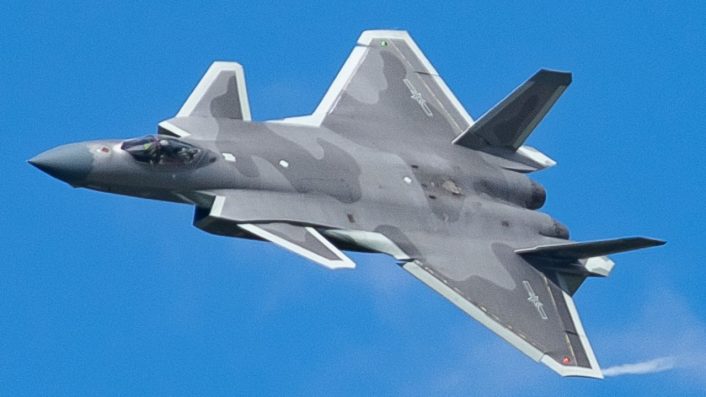The J-20 initially flew with the Russian Saturn AL-31 turbofan engine, which was later replaced by the domestically developed WS-10C while waiting for the final WS-15 engine specifically developed for the type.
China’s J-20A stealth fighter prototype has been captured in the first clear image with the domestically developed WS-15 engine, leading Chinese military aviation researcher Andreas Rupprecht said in a post on X. Rupprecht also shared a close-up image of the J-20A’s (serial number 2052) serrated exhaust nozzles, which are distinctly different, proving the presence of the WS-15.
The J-20A, with the characteristic factory yellow primer paint scheme, is operating from an unknown airfield, which could possibly be the CAC (Chengdu Aircraft Corporation’s) testing facility. The J-20A has a slightly different nose section, cockpit canopy and spine, the latter usually for housing additional fuel or avionics – or both.
And the very best! 😀 pic.twitter.com/fu8kd7eVDg
— @Rupprecht_A (@RupprechtDeino) September 8, 2024
The J-20 initially flew with the Russian Saturn AL-31 turbofan engine, which was later replaced by the domestically developed WS-10C in 2019. The WS-15 is expected to provide a higher thrust of 18,143 kg (40,000 pounds) and a ‘supercruise’ capability, which allows the plane to fly supersonic without having to engage the afterburners.
Beside improving its kinematic performance, as analysts had initially observed how the J-20 doesn’t seem to be able to make the tight turns and aerobatics like the F-22, the new engine would also offer more electrical power for advanced avionics and sensors and newer generation of radars. CAC and the PLA Air Force can be expected to adapt these into newer batches of the J-20, especially as it moves towards inducting wingmen drones for MUM-T (Manned-Unmanned Teaming).
J-20 and WS-15
Reports claiming the J-20 flying with the WS-15 go as far back as Mar. 2022. The SCMP (South China Morning Post) at the time quoted a feature by CCTV, saying that the WS-15 “was put through a series of tests.” Whether China would progressively retrofit all or some of its J-20s with the WS-15s, or only fly future production models with the powerplant is not known.
Probably WS-15 pic.twitter.com/bZyPQMRdcZ
— 乐子壬1号机 (@kt396) June 29, 2023
But given the heightened tensions in the western Pacific, re-engining a major portion of the fleet would be a tall order and the PLAAF cannot afford such a downtime for its leading stealth fighter. It can be safely assumed that J-20s flying with the WS-10C are considerably capable and perform a wide variety of mission sets.
In 2022, General Kenneth Wilsbach, then head of the Pacific Air Forces, said at a Mitchell Institute for Aerospace Studies conference that U.S. F-35s had encountered J-20s over the ECS (East China Sea) and that they are “relatively impressed with the command and control associated with the J-20.”
Here it is in all its beauty … J-20B no. 2052 with two WS-15 during its maiden flight 🥳 pic.twitter.com/7Hx9PkNvQW
— @Rupprecht_A (@RupprechtDeino) June 29, 2023
Another J-20A (serial number 2051) had appeared in Dec. 2022, The War Zone reported, concluding that this variant was expected to receive the WS-15. The Diplomat then reported that 2052 flew on Jun. 29, 2023, in its “first” flight from the CAC (Chengdu Aircraft Corporation) base, “newly powered by the WS-15 turbofan engines.”
This was after years of extensive development, ground and flight tests on flying test beds. Chinese newspaper Global Times quoted the editor of Beijing-based Aerospace Knowledge magazine at the time, who said “more powerful engines with vector thrust control and variable cycle engines are also likely under development.”
However, there was still some doubt from these images whether the engines were the WS-15, as the pictures were grainy and the exhaust nozzles could not be seen clearly. The latest images suggest that the engine is in the final stages of being tested with the J-20A variant it is meant to fly with, before both enter series production and join the PLAAF’s various Air Groups.

Conclusion
Jet engines are a highly niche, protected technology, and only the U.S., U.K., France and Russia have fully mastered the complete range of civilian and military power plants that make them leading aerospace powers. They are an intricate amalgamation of electrical, electronic, mechanical, chemical and metallurgical sciences with hundreds of complex parts, made with high-precision tools and robust industrial processes.
China had long invested billions in aero engine research with state research institutes and academia since the 1970s. Development of the WS-15 started in the 1990s. How it compares to the Izdeliye 30 that powers the new batch of Su-57s, the F-22 Raptor’s Pratt & Whitney F119 or the F-35’s PW F135 remains to be seen. While it might not be the best, it can be said that it is the best that works for the PLAAF and its needs.
J-20 pic.twitter.com/2uoeLhiNfp
— Enis Şenol (@senolenis) September 6, 2024
Combined with the fact that the J-20 has now reached mass production, where CAC now able to churn out 100 aircraft annually from just 30 units, with the PLAAF estimated to have 800 aircraft by 2030, massively outsizes the U.S’s F-22 and F-35 fleet. The key for the U.S. is now to quickly roll out the F-35s with the TR-3 (Technology Refresh-3) and Block 4 upgraded aircraft to stay ahead of the curve.
Having relatively less advanced but a large and constantly evolving fleet of fifth generation jets puts the mass in stealth fighters. It affords consistency and stability in air campaigns, leaving adjustments to be made only at the tactical level. Flying with an own supercruise capable jet engine is even better.









